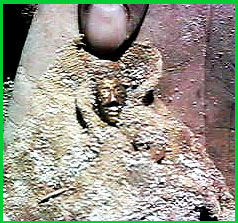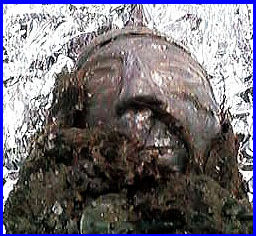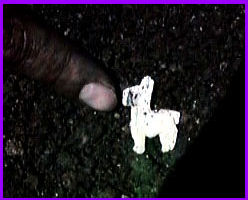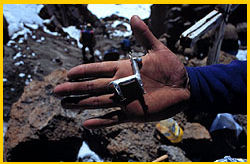 |
 |
 |
 Burial Artefacts
Burial ArtefactsPart 3 (back to Part 2) Gold Male Statuette When this statuette was first pulled out of the ground, it was thought to be male. But the clear presence of a tupu suggests that it may be a female. Bill Conklin also notes, "this is a standard female. Although the Inca standardized their small figurines like this one, what is remarkable is that these are the last and only representatives of the spectacular use of metals by the Inca. It's hard to imagine, but the Inca had full-sized gold statues like these small figurines. They made gold statues of all their deities. But due to the great meltdown, when the Spaniards pillaged and melted down all of the Inca gold, there are no full-sized statues left." Conklin believes these figures are representations of Inca deities, rather than symbols of individual people. And the gold itself may be a signifier of the gold-coloured Sun God. "When you look into the eyes of these figures it gives us a glimpse into the heart of Inca tradition. The wide open eyes and solemn presence is almost calming."  Silver Male Statuette
Silver Male StatuetteThis statuette remains a puzzle. In the field it was at first thought to be male; however, it looks as though there is a metal shawl pin present. To further complicate matters, Bill Conklin notes that the face and hair seem to signify a male. Male hair on Inca figurines is generally cone-shaped and made to carry a headband whereas female hair is typically parted in the center and pulled back.  Spondyllus Llama
Spondyllus LlamaSpondyllus, a shell that is ideal for carving and comes from the shores of Ecuador, was coveted by the Inca. "Spondyllus means the sea and when they buried spondyllus, the Inca were bringing the ocean to the mountains. The Inca thought in cosmic terms," comments Conklin. Because of its more compact build, Conklin suspects that what we thought was a llama carving on Sara Sara might actually be a baby alpaca.  Silver Llama
Silver LlamaMy favourite of the artefacts discovered on Sara Sara—this silver llama—was found in perfect condition, without tarnish, in a textile bundle. The brilliance of its shine was a surprising contrast to the brown mud and ice from which it was unearthed. The llama stance, with its tail out, signifies what archaeologists often refer to as an "excited" state which represents fertility. It appears that many of the male Inca figurines, both human and animal, are depicted in this excited state, apparently symbolizing fertility. Continue Expedition '96 | Dispatches | Mummies | Lost Worlds | Mail Resources | Site Map | Ice Mummies of the Inca Home | BBC Horizon Editor's Picks | Previous Sites | Join Us/E-mail | TV/Web Schedule About NOVA | Teachers | Site Map | Shop | Jobs | Search | To print PBS Online | NOVA Online | WGBH © | Updated November 2000 |